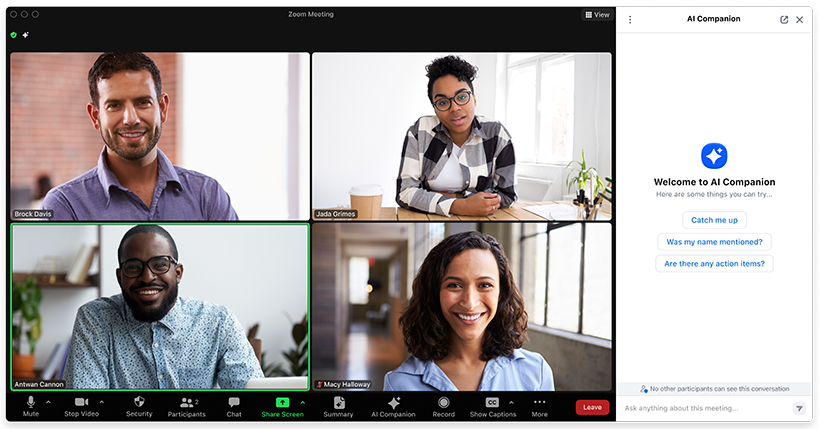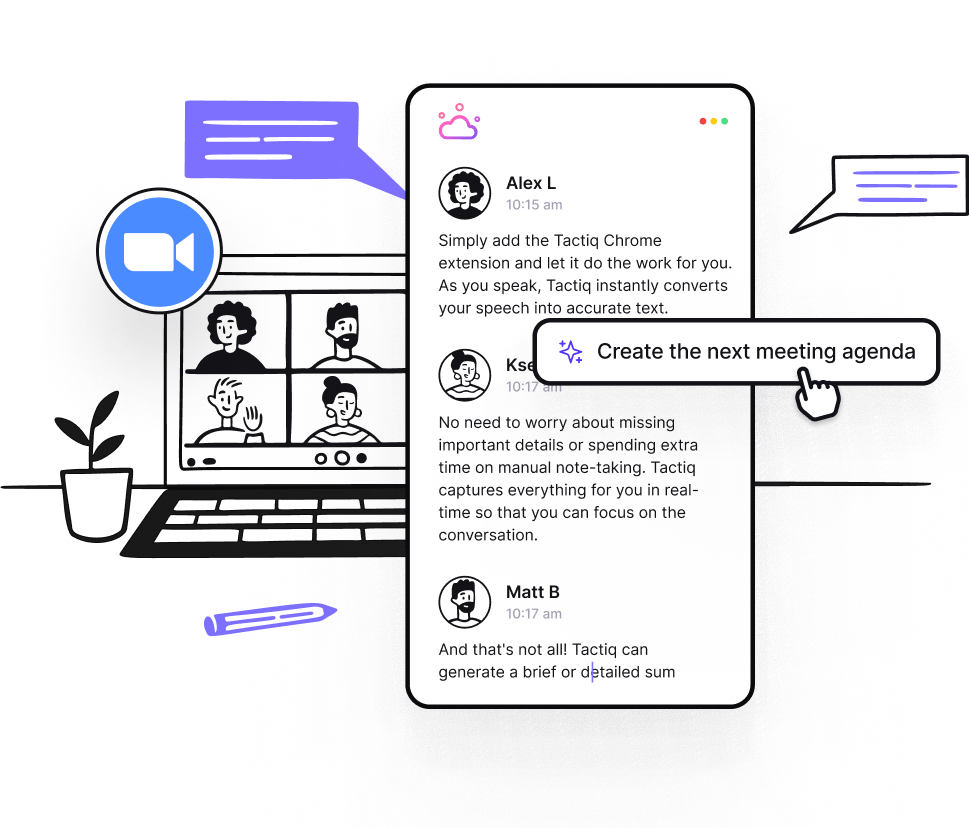How to Recover Zoom Chat for a Non-recorded Meeting
April 1, 2025
April 1, 2025
June 12, 2025
June 12, 2025
Lost your Zoom chat after a meeting that wasn’t recorded? Many users assume Zoom automatically saves chat messages, only to find out later that their in-meeting chat history is gone once the session ends.
The problem? If you didn’t hit “Save” or record the meeting to the cloud, recovering that chat can be tricky, sometimes even impossible. And while there are ways to prevent this from happening again, they’re not always evident from the Zoom web portal.
In this guide, we’ll explain how Zoom saves chat messages, what options there are for recovering meeting chat from a non-recorded session, and how to set up autosave to avoid losing valuable information again.
How Are Zoom Chats Saved?
Zoom gives you a few ways to save chat messages, but not all of them happen automatically. It depends on how your meeting is set up, your account settings, and whether or not the meeting was recorded.
When the call is recorded
If you’ve enabled cloud recording, Zoom automatically saves the meeting chat along with the video, audio, and transcript. This only works if you have a paid plan and the proper recording settings are turned on. In this case, the chat transcript is saved in the Zoom cloud and can be downloaded after the meeting.
If you use local recording, the chat may be saved to your device, depending on your version of Zoom and whether the setting is enabled.
When you manually save the chat

Even if you're not recording, you can still save chats manually during a Zoom meeting. Just open the chat window, click the ellipsis (three dots), and choose Save Chat. This saves in meeting chat messages—both public and private (if you're the host)—to your local recording location.
But if no one hits save before the meeting ends, those chat messages are lost.
Things you’ll need to save the chat
To make sure your meeting chats get saved, here’s what you’ll need:
- A Zoom Pro, Business, or Enterprise account is required if you want to use cloud recording and access advanced cloud recording settings.
- Access to your account settings in the Zoom web portal.
- Having the chat feature enabled for your account.
- For local saving, make sure you know where your local recording location is set.
How to Recover Zoom Chat for a Non-Recorded Meeting

If your Zoom meeting wasn’t recorded and no one clicked “Save Chat” before it ended, recovering the in-meeting chat is, unfortunately, not possible. Once the meeting ends, unsaved chat messages are permanently deleted.
Here’s what that means in practice:
- The chat transcript isn’t stored anywhere—not in the cloud, not locally.
- Even hosts can’t access chat history after the session ends unless it was saved manually or included in a cloud recording.
- There’s no built-in recovery feature in the Zoom web portal for unsaved chats.
So, what can you do now? If the meeting just ended, your best bet is to check with participants. Sometimes attendees may have saved the chat locally or taken screenshots. It’s not ideal, but it’s worth asking.
Moving forward, the best solution is to turn on auto-saving chats in your Zoom settings. That way, you won’t have to rely on memory or anyone else to keep track of what was shared in the meeting chat.
How to Autosave Zoom Chats
Zoom gives meeting hosts the option to automatically save in meeting chats, so you don’t have to rely on clicking “Save Chat” during the call. But this feature isn’t on by default—you’ll need to turn it on in your settings before hosting.
How to enable auto-saving chats

To automatically save chats during meetings you host:
- Sign in to the Zoom web portal.
- In the navigation panel, click Settings.
- Click the Webinar tab.
- Under the In Webinar section, find Meeting Chat – Auto-save and toggle it on.
Once this is enabled, Zoom will save in-meeting chat messages to your device after each meeting—no extra clicks needed. But here’s the key detail: only the host can use this feature, and they must be present in the meeting for the local chat transcript to be saved.
How to save a meeting chat to the Zoom cloud
If you’re using cloud recording and have a paid Zoom account, you can save chat messages to the Zoom cloud automatically. Here’s how to enable it:
- Sign in to the Zoom web portal.
- Go to Settings and click the Recording tab.
- Turn on Cloud recording.
- Check the box next to Save chat messages from the meeting/webinar.
- To save more detailed chat files in webinars, enable Save panelist chat to the recording under Advanced cloud recording settings.
Don’t forget: the cloud chat transcript only saves if you start the cloud recording or have automatic recording turned on before the meeting starts.
How to access saved in-meeting chats on the cloud
Once the recording finishes processing, you’ll get an email with a link to the files. Or you can find Zoom recordings like this:
- Sign in to the Zoom web portal.
- Click Recordings, then choose the Cloud Recordings tab.
- Select your meeting.
- Look for the .txt file labeled Chat file—this contains the saved chat messages.

Image from Zoom
You can download, share, or delete it from there.
Want to know how to export transcripts from Zoom recordings? We’ve got a full guide to help you with that.
Where Are Zoom Chats Saved on Windows
If you’ve enabled auto-saving chats, Zoom will automatically save the local chat transcript to your computer after each meeting you host. On Windows, the default location is:
C:\Users\[YourName]\Documents\Zoom
Inside this folder, you’ll see a subfolder for each meeting. Open the relevant folder, and you’ll find a .txt file—usually named chat.txt—containing the saved in-meeting chat messages. This includes any public messages and private messages sent to or from the host.
Where Are Zoom Chats Saved on Mac
On a Mac, the saved chat messages can be found in a similar place:
/Users/[YourName]/Documents/Zoom
Each meeting will have its own folder. Inside, you’ll find a .txt file with the chat transcript. If you don’t see it there, check your Zoom desktop client settings under Recording to confirm or change your local recording location.
If you’re running into the limits of Zoom’s built-in features, like not being able to recover unsaved chats, it might be time to explore other tools. Check out the best Zoom alternatives for video meetings.
{{rt_cta_ai-convenience}}
How to Use AI to Take Notes on Zoom Automatically

Have you ever ended a Zoom meeting and realized you lost the chat and the important takeaways? Zoom gives you some tools to save in meeting chats, but they don’t always cover everything. If someone forgets to hit "Save Chat" or the meeting wasn’t recorded, that information is gone.
To avoid that stress, you can use a tool like Tactiq—an AI note taker for Zoom that captures everything said during your meeting in real time. While it can’t save chat messages, it does automatically generate a transcript so you can refer back to key points later.
When using Zoom in the web browser or Google Meet, chat messages are included directly in the Tactiq transcription and are labelled as “Speaker.” So if someone types a comment or drops a link in the chat window, it’s saved alongside the spoken conversation.
Tactiq Features for Zoom AI Workflows
- Live Transcriptions: Automatically take notes on Zoom as the conversation happens.
- AI-Powered Summaries: Get quick highlights, summaries, or next steps post-meeting.
- Export Zoom transcripts to platforms like Notion or Google Docs.
- Custom Prompts: Use AI to extract insights or write follow-up messages.
- Meeting Kits: Save your favorite prompts and templates to automate taking notes on Zoom every time.
- Zoom AI Workflow Builder: Turn transcripts into actions—like tickets, docs, or updates—with one click.
- Quick Search: Jump to specific parts of the conversation using keywords or names.
- Multi-language Support: Transcribe meetings in 50+ languages.
- Privacy First: Tactiq doesn’t save recordings, just the transcript.
If you're looking for more control over your meeting records and want to avoid the hassle of manual notes, Tactiq offers an easy way to automate your workflow and stay organized.
Wrapping Up
Zoom makes it possible to save meeting chat messages, but only if you’ve set things up ahead of time. If the meeting wasn’t recorded or the chat wasn’t saved manually, there’s no way to recover it after the session ends.
To avoid losing important links, notes, or messages, make sure auto-saving chats is enabled in your settings, or consider using cloud recording with chat saving turned on. And if you're looking for a smarter way to capture your meetings overall, tools like Tactiq can help you stay on top of what was said, even without a recording.
No. Unless the chat was saved manually or included in a cloud recording, participants can’t access the meeting chat after the session ends.
Check your Zoom folder for local chat transcripts or visit the Zoom web portal if you recorded to the cloud. If the chat wasn’t saved, it can’t be recovered.
Enable “Auto saving chats” in your Zoom settings or click “Save Chat” manually during the meeting. No recording is needed to save in meeting chats locally.
Zoom only keeps chat history from recorded meetings saved to the cloud. These are stored until you delete them manually or your storage limit is reached.
Tactiq automatically transcribes your Zoom meetings in real time, so you always have a record of what was said, even if the chat isn’t saved. You benefit from AI-powered summaries and searchable transcripts, making it easy to find key points and action items after every call.
Want the convenience of AI summaries?
Try Tactiq for your upcoming meeting.
Want the convenience of AI summaries?
Try Tactiq for your upcoming meeting.
Want the convenience of AI summaries?
Try Tactiq for your upcoming meeting.









